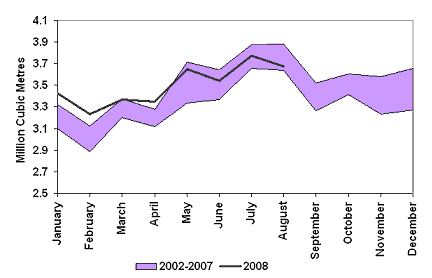ARCHIVED - Canadian Energy Demand: Passenger Transportation - Energy Brief
This page has been archived on the Web
Information identified as archived is provided for reference, research or recordkeeping purposes. It is not subject to the Government of Canada Web Standards and has not been altered or updated since it was archived. Please contact us to request a format other than those available.
Canadian Energy Demand: Passenger Transportation - Energy Brief [PDF 84 KB]

January 2009
Canadian Energy Demand: Passenger Transportation - Energy Brief
Canadians enjoy driving and it is understandable.
Canada is a big place with a population that spreads from coast to coast to coast. It is also a country with an economy that is largely fuelled by the production of goods and commodities, such as lumber or coal, which must be transported to market. About half of the 2,492 petajoules of energy used for transportation in Canada last year was for moving goods.
However, the other half of that amount was used to move people. In fact, Statistics Canada estimates that Canadians traveled more than 300 billion kilometres in 2007. To put this in perspective, that’s about 390,215 return trips from Earth to the moon. Drivers in Saskatchewan and Alberta spend the most time in their vehicles, travelling an estimated 20,000 passenger-kilometres per person in 2007. In comparison, drivers in Newfoundland and Labrador, British Columbia and Quebec travelled less than 15,000 passenger-kilometres per person.
In 2006, roughly a third of all end-use energy consumption in Canada was used for transportation. And 99 per cent of all energy used for transportation in 2006 came from oil products.
Increasing Energy Demand for Transportation
Energy used for transportation is the second largest end-use sector in Canada - and it's growing. From 1990 to 2006, average energy use for passenger transportation increased by 0.9 per cent per year.
Over the last two decades, our growing population and incomes, relatively low energy prices, increasing transportation activity and changing consumer preferences about where we live and what we drive have all contributed to the growth in energy demand for transportation. For example, twenty years ago, 70 per cent of all new vehicle sales in Canada were cars. By 2007, light trucks, minivans and SUVs accounted for nearly half of all Canadian vehicle sales and 60 per cent of all vehicle sales in Saskatchewan and Alberta during the first half of 2008.
While vehicles are becoming more fuel efficient, the combined fuel economy of Canadian new car and light truck sales has barely moved over the past 20 years as more Canadians buy light trucks, such as pick-ups, minivans or SUVs. In 2006, the combined fuel economy of passenger cars and light trucks was 9.0L/100 km, almost exactly the same as it was in 1988.
Factors that have also contributed to the increase in energy demand for transportation include:
- Driving is affordable – Until the summer of 2008, the proportion of disposable income spent on gasoline was only around three per cent.
- Suburbs have grown by 11 per cent between 2001 and 2006, twice the national average growth rate. As the distance between home and the city core increases, so too is the likelihood that Canadians will drive. Canadians traveled an estimated median of 7.6 kilometres to work in 2006, up from 7.0 kilometres in 1996.
- Canadians are becoming more dependant on their cars. In a 1992 survey, 68 per cent of Canadians aged 18 and over said they had travelled everywhere that day by car. In a similar 2005 survey, this number jumped to 74 per cent.
Recent Trends in Energy Demand
Transportation energy demand is generally more sensitive to changes in personal income than changes in price. For example, despite the dramatic jump in global oil prices in recent years, growing incomes ensured that Canadians continue to drive. In fact, gasoline sales in Canada rose 7.4 per cent between 2002 and 2007.
Figure 1: Domestic Motor Gasoline Sales, 2002-2008

Source: Statistics Canada
In the first quarter of 2008 as gasoline prices began to soar, Canadians drove their light trucks 15 per cent less and their cars eight per cent more. As of August 2008, light truck sales in Canada were down 5.4 per cent over 2007 and car sales jumped 7.7 per cent. This could suggest that consumers were responding to rising oil prices by switching to more fuel efficient vehicles. Furthermore, ridership on ten major urban transit systems in Canada this year is higher than it has been over the last five years.
Looking Ahead
With energy demand for passenger transportation accounting for about 16 per cent of total energy use in this country, future changes to the way we move about have the potential to significantly impact the way Canadians use energy. Some of the ways total crude oil demand could be reduced include changes to vehicle technology, replacing oil products with ‘greener’ fuels such as ethanol, a shift in consumer preferences and new government regulations.
For example, according to the U.S. government, only about 15 per cent of the energy used in a typical gasoline vehicle is for moving the vehicle or running its accessories, such as air conditioning. The rest of the energy is lost to idling and inefficiencies. Vehicle improvements, such as advancements to gasoline engine and transmission technologies and lightweight vehicle body materials, developing hybrid electric vehicles, clean diesel vehicles and alternative fuel vehicles have the potential to significantly improve fuel efficiency.
There are also various government programs and policies that could influence passenger transportation energy consumption in Canada, including:
- Proposed changes to vehicle fuel efficiency standards; and,
- Proposed and/or enacted legislation requiring gasoline and diesel fuel to include ethanol and biodiesel.
- Date modified:
